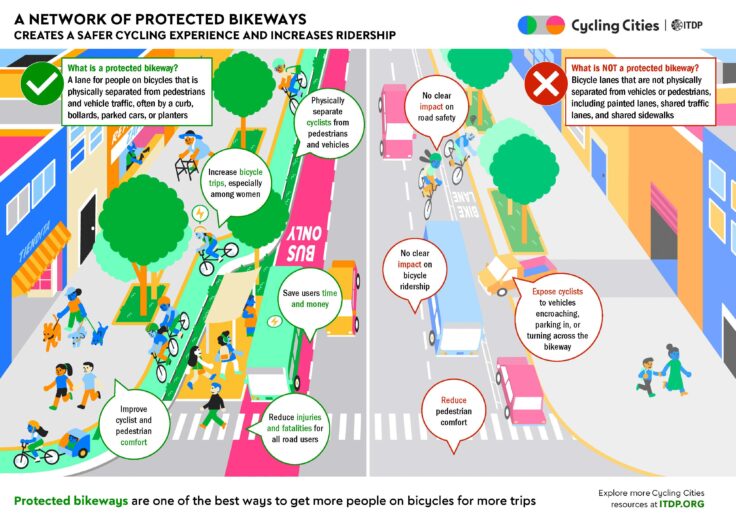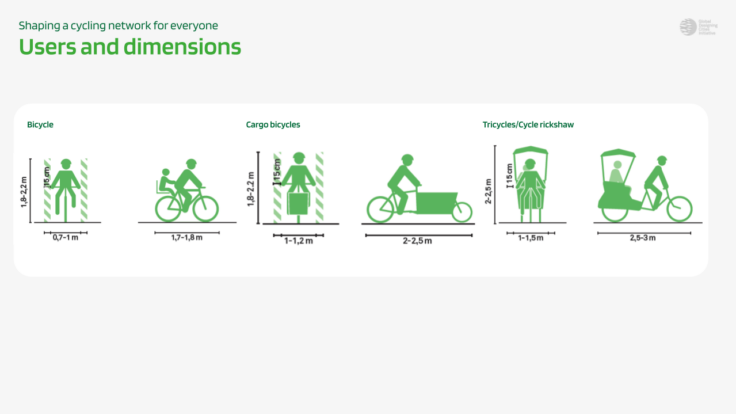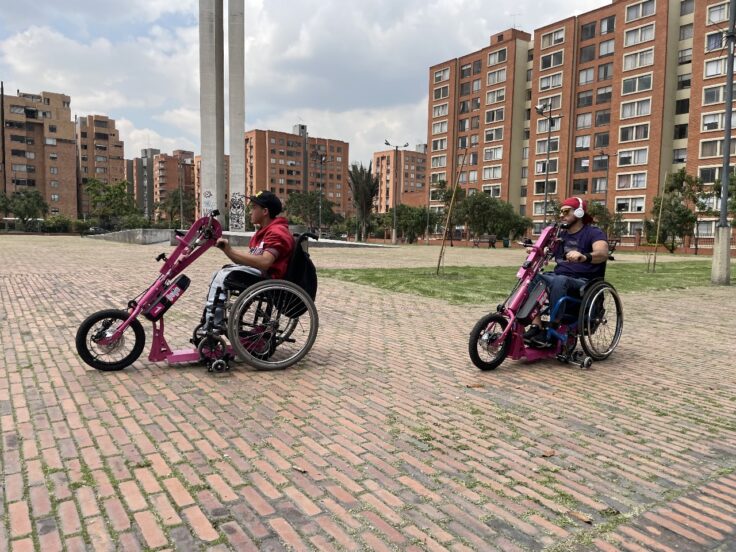June 25, 2024
We Need to Make Cycling Inclusive and Accessible to All
When cities plan mobility systems for people with different abilities, they function better for all people.
Continue reading ITDP’s resources on urban access and mobility here.
As cities worldwide face challenges of congestion, pollution, safety concerns, and inequality in mobility, these issues often impact marginalized groups the most. Particularly, people with disabilities, children, older populations, and women are disproportionately affected by urban and transport designs that fail to consider their perspectives and unique travel needs. The inclusion of universal design criteria in designing our streets and public spaces could allow everyone to move and travel as they need, but all too often our pedestrian and cycling infrastructure does not receive the necessary planning, investment, and support to insure access for all.
When designed as an essential transport mode in cities, cycling can offer a number of benefits for short and medium trips: improved physical health, fewer greenhouse gas emissions, and lower transport costs. Significant obstacles stand in the way of its universal adoption and systemic challenges prevent underserved groups from enjoying the freedom and convenience of cycling. Understanding the challenges and solutions to achieving cycling cities that serve all communities is crucial to a future of sustainable and equitable urban mobility everywhere.
ITDP convened advocates, researchers, and policymakers to highlight these issues in a webinar on ways to achieve cycling for all by addressing infrastructure flaws, policy improvements, and societal needs.
Why Do We Need Inclusive Cycling Policies?
More people who choose cycling for urban trips leads to safer roads, improved public health, and fewer emissions from cars – outcomes that benefit everyone. However, to encourage more cycling trips, people need safe, separated spaces on streets to ride. Access to this cycling infrastructure is unequal across income and gender, even for communities that are more often than most dependent on bicycles for mobility. This unequal access impacts the ability of some groups to reach key job destinations, healthcare, and other services. Lorena Freitas from ITDP Brazil highlighted their extensive research into the challenges that prevent women of color in Brazilian cities from having equitable access to cycling and independent mobility.
Similarly, Kasih Sabandar from ITDP Indonesia put a spotlight on complementary research from the team that further demonstrates that inequities in cycling is a global issue for marginalized communities. ITDP Indonesia found that traditional data collection methods did not capture the needs of all types of communities and refined their approach to understanding the gender issues impacting cycling in the country’s cities.
The research identified key issues – that are universal in many cases – such as a lack of protected bike lanes, lack of personal security, and lack of access to bicycles themselves. Understanding the major obstacles that prevent marginalized groups from choosing cycling is key to creating better, evidence-based strategies for the future. Including underserved groups in infrastructure planning and design is also needed.
Safer cycling infrastructure is key to inclusive mobility for all. Download this infographic.

How Can Policy and Planning Elevate Cycling for All?
The goal of mobility justice, or re-allocating resources towards those with the least access to transport and mobility, should be central to the actions of cities and decision makers seeking to create inclusive transport systems. Kay Inckle from the UK-based Wheels for Wellbeing highlighted the importance of mobility justice for people with disabilities–who make up 20% of the UK’s population–in particular during the webinar discussion. The economic, social, and health inequities faced by people with disabilities is compounded by a lack of access to suitable mobility options that exacerbates costs and limits opportunities.
Cycling (using a variety of bicycle types from hand-cycles, to tandems, to recumbent bicycles) is recognized as a fundamental solution for many of these challenges because it offers an independent transport option that people with disabilities can use to access destinations and services. Wheels for Wellbeing research found that a majority of people with disabilities in their network identified cycling as easier and more essential than walking. However, to address the physical and social barriers to accessible cycling, there needs to be more local and national policy standards that ensure that all types of bicycles and non-standard vehicles are accommodated on city streets. Wheels for Wellbeing is also working to have bicycles recognized as mobility aids in the UK, which would help to expand access and use by people with disabilities.
Hila Bar Ner from the Global Designing Cities Initiative (GDCI) discussed the importance of re-designing streets in cities worldwide, particularly for children and caregivers. This requires a complete street approach that prioritizes space for cycling, walking, and public transit over motor vehicles. A network of wide and protected cycle lanes combined with safe intersections and crossings is the foundation for more inclusive streets for everyone. It is also critical to understand who is (and is not) cycling, why, and how even temporary infrastructure that separates cyclists from vehicles can encourage more children and families to use a bicycle.

Another critical component is to accommodate more types of trips by bicycle. Chicanes and other street designs that reduce vehicle speeds, and cycle lanes that accommodate groups of riders or goods delivery are ways to do this. Using a combination of safe cycling facilities and traffic management is foundational to designing a network that serves all mobility needs.
From a policymakers perspective, Deyanira Avila Moreno (Director of the Regional Mobility Agency for Bogotá and Cundinamarca, Colombia) has led pioneering efforts to transform Bogotá into one of the world’s most cycling-forward cities. Deyanira worked on the expansion of the city’s cycling network to over 630 kilometers of lanes, over 69,000 bike parking spaces, and the expansion of an innovative bikeshare system with Tembici.
The city now has over 1.2 million daily trips made on bicycles with a focus on gender equity in ridership as well as inter-city cycling connections. Deyanira gave context on Bogotá’s long history with urban cycling, such as the famed weekly Ciclovia open street event that has inspired other cities worldwide. The city’s progress included targeted policies and strategies to encourage cycling access and promotion amongst groups of all ages and abilities.

Perhaps one of Bogotá’s most impressive cycling inclusion efforts is its bikeshare program, which launched in 2022. It is the world’s first bikeshare system that offers a variety of bicycle types, including hand cycles, bikes with child seats, electric bikes, and cargo bikes. Inclusion of these different bikes is meant to better support women making care-related trips, and the system aims to position its special vehicles in areas that facilitate better mobility for women, children and caregivers. The bikeshare system has now supported over 1.7 million trips and has reported the lowest level of theft and damage of vehicles, demonstrating its importance to residents. Active citizen participation and embrace of cycling through initiatives like neighborhood Bike Councils allow the public to also engage with decision makers with daily needs and perspectives.
In the end, the webinar discussion centered on the importance for urban and transport planners and policymakers to incorporate inclusive and universal design standards into their decisions. Low-cost, efficient infrastructure interventions that accommodate all types of cycling vehicles is key and can already be seen in practice in cities all over. Beyond physical changes, broader policies are needed to ensure that road space is shared, safety is prioritized, and vehicle speeds are reduced. Centering the perspectives of people with disabilities, women, and children (who are largely left out of planning and design decisions) delivers infrastructure and policies that better serve these groups and work for everyone.
Cities and streets that make active mobility inclusive and friendly to everyone, no matter gender, ability, or age, are ones that are truly equitable and sustainable for all. Watch the webinar in English and Spanish here.
